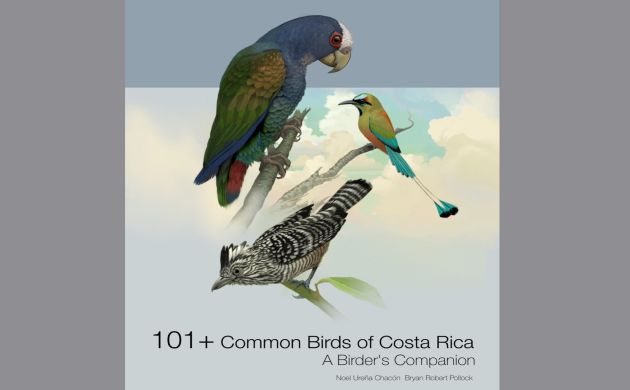
Costa Rica is a small yet very birdy country (readers may have gotten that impression on previous posts I have written for 10,000 Birds, at least I hope that has been the case!). To give an idea of what I mean by “birdy”, although Costa Rica is similar in size to West Virginia, more than 920 species have been recorded within the borders of this southern Central American country. The biodiversity is extreme, the birding is typically action-packed, binocular raising happiness. With that in mind, it’s always a pleasure to see more books and information available about birds and birding in Costa Rica. Since I have been checking out, studying, and marveling over birds in Costa Rica for more than twenty-five years, I was pleased to hear about a new e-book, “101 + Common Birds of Costa Rica” and even more pleased to be asked to review it.
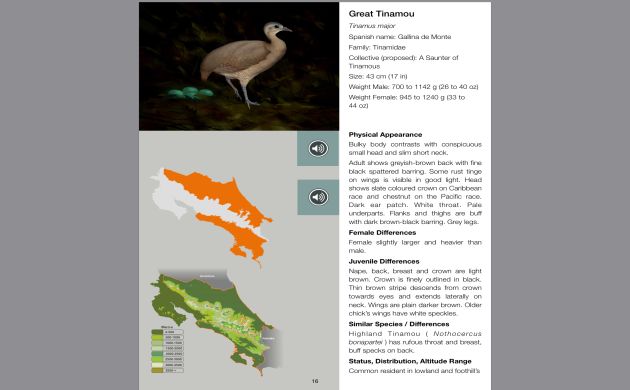
A part of the Neotropic Bird Project, according to the authors, this e-book is meant to be a “definitive field guide to the more common birds of a not so common region of the world”. In referring to it as a “birder’s companion”, this book also seems to be meant to accompany other field guides that cover most or all species on the Costa Rica list. 101 + Common Birds of Costa Rica covers just what the title implies, a bit more than 100 of the common (and perhaps more spectacular) bird species that occur in Costa Rica. With so many species to choose from, it’s far from easy to decide which merit inclusion. Other books and apps about common birds in Costa Rica have settled on 300 or so species and even then, that still leaves out more than 600 species (!).
In this case, the authors settled on birds that are common as well as species that might not be so common but are frequnetly seen on tours and/or shown to even non-birding tourists because they are simply spectacular. Those would be birds like the unique Sunbittern, the endangered and larger than life Great Green Macaw, and the downright strange Great Potoo. I think these work for this book as well as the many other more easily and commonly seen birds found within its digital pages.

Some other aspects of this e-book:
Introductory Pages
I love a field guide that has more information than illustrations. It’s also nice to read about protected areas, different habitats, and more information about each bird especially when you don’t have to worry about more pages adding more weight to your field pack. This book starts with nice maps showing the locations of various protected areas as well as the “biozones” and provinces of Costa Rica. It’s wonderful to see where all forest reserves and protected areas are located even if some of the names don’t coincide with those used in eBird or on birding itineraries. The locations of protected areas in relation to accommodation and itineraries are still easy enough to figure out, it’s always worth it to have this information. I couldn’t find any definitions for the biozones and although maybe none are needed for “Lowland Rainforest”, I would have liked one for “Highland Forest” because based on the map, this biozone seems to refer to paramo and adjacent high elevation forest. However, paramo and similar temperate zone rainforests also occur on Irazu Volcano and a few other areas that are indicated as “cloud forest” on the map.
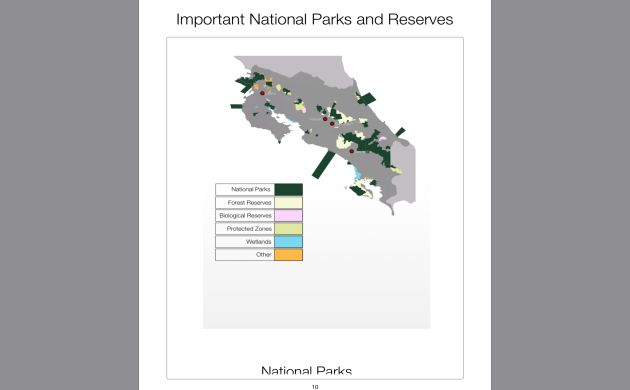
Good illustrations are given for the anatomy of a bird, including a digital video of a wing in motion. There are also a few illustrations of plants that are of special importance for birds.
Illustrations
Illustrations are vivid and digitally made on an iPad with the Procreate app. Overall, they show a good, accurate representation of each species and although the colors can look a bit saturated for some birds, they sure are nice to look at. The downside of illustrations made with Procreate (at least these ones) is that several falter when it comes to subtle shapes. Many species seem to have larger than normal heads or other subtleties that don’t quite match how the bird exactly looks in life. I suspect that it might be difficult to capture those subtle proportions with digital drawings. That said, I don’t think they deter so much from the illustrations to significantly take away from their utility or quality. They are still very nice to look at, show the birds quite well, and in vegetation and/or backgrounds where each species is usually seen. Another bonus is being able to “click” on illustrations and enlarge them.
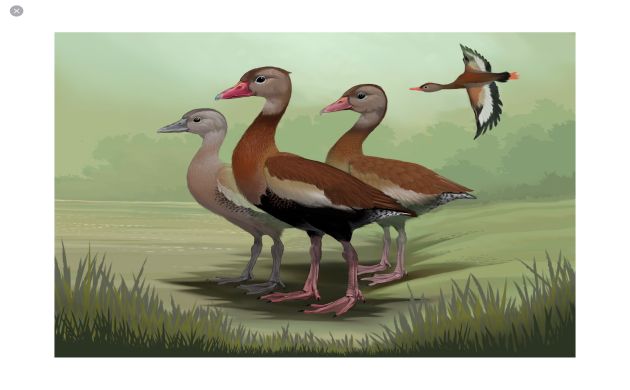
Most species are also shown with adult and juvenile plumages and several are also shown in flight. Exceptions are Bay-headed Tanager and Roadside Hawk. I would have liked to have seen a juvenile plumage of the tanager and of the hawk in flight as both species are often encountered like so in the field. That said, a description of the juvenile tanager is provided in the text. As for the hawk, I am guessing that there wasn’t enough room to show it on the plate. To me, the legs of the Blue Dacnis also seem to be “pinkish” but perhaps that’s what “raw sienna” actually describes.
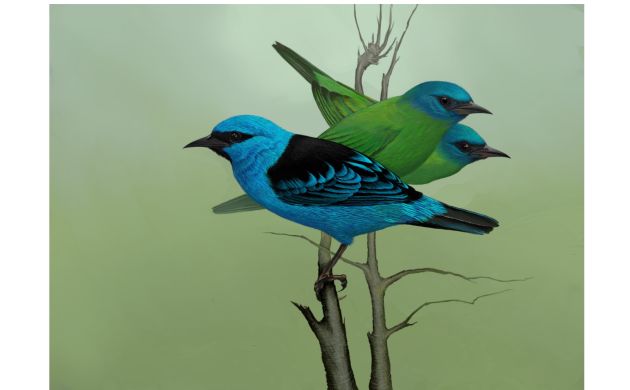
Text
The text is thorough and informative. It includes:
-Names of the birds in English and Spanish
-Dimensions for each species
-Physical Appearance
-Juvenile Differences
-Similar Species/Differences
-Status, Distribution, Altitudinal Range
-IUCN Conservation Status
-Behaviour
-Nest
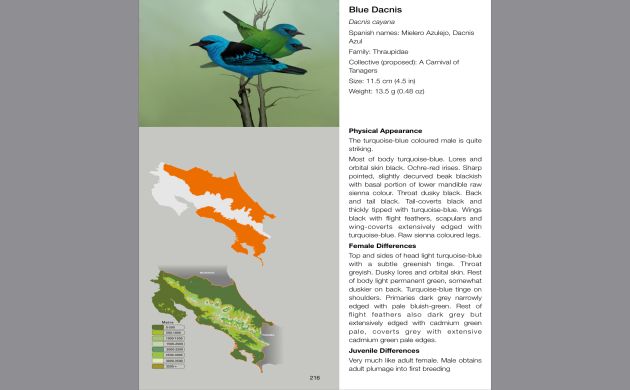
In other words, the text includes most or all of what birders would be interested in. I found the “Behavior” section to be especially interesting as it details where and how each species is typically encountered. Notes on food items and other information are also given and demonstrate the author’s field knowledge and love for his country’s avifauna. Sometimes, a link to a video or other bits of information are also provided for a species.
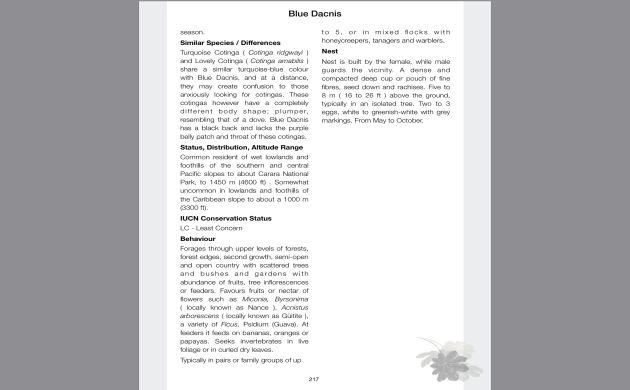
In going through most species accounts, the only errors or critiques I found were the IOC name for “Mealy Parrot” being shown as “Southern Mealy Parrot” whereas the birds that reside in Costa Rica are actually “Northern Mealy Parrot”. Red-lored Parrot is also mentioned as having suffered from deforestation when actually, this edge species species has benefited from at partial deforestation.
The “similar species” accounts are also good although I would have expected Broad-winged Hawk to be mentioned in the account for Gray Hawk because the juveniles of these two species are often confused.
Vocalizations
This e-book demonstrates once again the advantages that digital media has over most printed books when it comes to vocalizations. As with other interactive media, a birder can listen to vocalizations of a bird while looking at pictures and reading text. Sounds are provided for most species, are accurate, and are for the most part, well done. The one species for which a vocalization is missing seems to be Gray Hawk as this bird is frequently vocal and a common part of the soundscape in many areas of Costa Rica.
Overall, though, the recordings are excellent and of great value for this field guide. If I had any further critiques, it would be that recording of Silver-throated Tanager and a few other species might be confused with calls of other birds on the recordings, and that a very few recordings lose important characteristics with editing. However, these are also of species like Speckled Tanager, a bird that makes chip notes that always seem to sound different from ones in the field no matter how they are recorded or edited.
Range Maps
The range maps are excellent, up to date and include two maps; one showing the range of the bird in orange and a second that shows where the range overlaps with an elevational gradient. The only possible small range issues I noticed were for Gray Hawk (they range further south although I suspect that the author decided to play it safe with this species since the range of the closely related Gray-lined Hawk in Costa Rica is still being determined), Gray-cowled Wood-Rail occurring on the southern Caribbean slope, and showing Scarlet-rumped Tanager as occurring in the Central Valley.
Is this a definitive field guide to various common birds in Costa Rica? I am reluctant to say that it is but that’s more because I don’t know if there can be such a book. Ranges and abundances change and birds can always be shown in more plumages and from different angles. However, 101 + Common Birds of Costa Rica comes close enough to act as a valuable and informative field companion for any birder visiting Costa Rica. I foresee it as a useful tool to prepare for a trip as well as during birding time in Costa Rica.
____________________________________________________________________________________________
101+ Common Birds of Costa Rica: A Birder’s Companion
by
This is an interactive e-book available in Kindle format ($19.99), and in iBook format ($19.99)










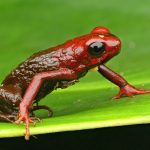
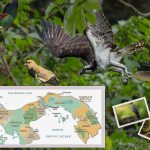
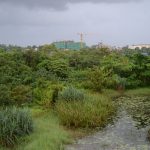
Thanks for reviewing this ebook. Guides for a place like Costa Rica are so large it is challenging to carry them in the field. I think it is a great idea to have a guide that can quickly help to ID some of the more common birds.